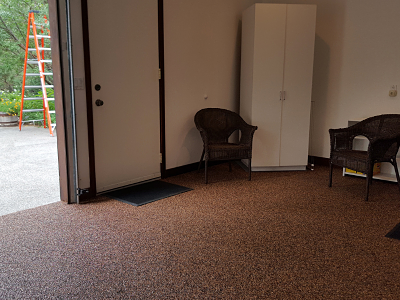Epoxy floor coating, Let’s talk about why you should consider installing it.
Concrete Floor Protection
So, why protect concrete floors? The main reason is to protect the concrete structure from deteriorating or becoming contaminated. Other reasons include providing slip or chemical resistance, ease of cleaning and maintenance, better physical performance, aesthetics, durability and much more.
Whether industrial or commercial epoxy floor coating system, there is no other surface in a building or structure that has to endure the wear and tear and abuse a concrete floor goes through. Gravity, along with poor housekeeping and heavy duty actions upon the floor, are the drivers of abuse in these busy environments.
Just some of the regular abuse commercial and industrial floors are subjected to include impact, thermal shock, abrasion and attack from chemicals. While concrete is robust, it’s not impervious to abuse and isn’t designed to withstand abuse on a continual basis. Also, because concrete floors are porous, wear and tear on them tends to create dust. As mentioned, they are also regularly subjected to abrasion and chemical attacks.
No matter where it is located, all concrete floors need added protection to protect the surface and to ensure longevity and safety. The problem is determining what type of floor protection will work best for a particular environment or different conditions. Not all concrete floors are the same and neither are all working conditions the same.
Epoxy floor coating systems come in many forms, the most common being:
-
- 100% solids epoxy floor coatings
- Solvent based epoxy floor coatings
- Water based epoxy floor coatings/gloss
- Water based epoxy floor coatings/matt
Each of these epoxy floor coatings are produced of various qualities depending on the manufacturer, also, can be thinned with either solvents or water. A 200 micron thick epoxy floor coating is regarded as a “high build” coating. Most epoxy floor coatings are tintable.
Preparation of substrate for Epoxy coating
Most common methods of concrete preparation for coating:
- Diamond grind – world’s best practice
- Acid wash – generally used in DIY situations
Diamond grind is by far the best preparation method because it removes a millimetre or so of the surface of the concrete taking away contaminants and provides a profile scratch pattern which enhances adhesion.
Contaminants can cause blistering and or peeling of the epoxy after curing.
A common problem with epoxy flooring is a phenomenon known as “hot tyre peel”, diamond grind preparation performed properly virtually eliminates this problem build” coating. Most epoxy floor coatings are tintable.
How do we get it right?
The selection process comes down to:
- Service conditions need to be evaluated to define physical requirements
- Evaluation of the concrete floor is necessary to determine its age, joints, strength, and overall integrity
- Other issues need to be considered – aesthetics, maintenance-free periods, budget, and application parameters
- Select the flooring system you want
- Select a competent applicator
The top 10 places epoxy floor coating are applied
- Warehouses
- Motor vehicle workshops
- Residential garages
- Retail shops
- Supermarkets (back of house-butcher/baker etc
- Food preparation areas (health regulation)
- Commercial kitchens
- Walkways
- Aircraft hangers
- Cold rooms
……………………….and many more suitable situations
Maintenance of an epoxy floor
Sweep or blow/cold water mop/hot water mop
hot or cold with or without soap
squeegee/high pressure wash/scrubvac/ride on scrub vac

